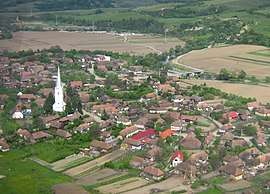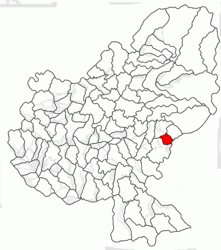Chibed
Chibed (Hungarian: Kibéd, Hungarian pronunciation: [kibeːd]) is a commune in Mureș County, Transylvania, Romania, composed of a single village, Chibed. It lies in the Székely Land, an ethno-cultural region in eastern Transylvania. The village is famous for the onion produced in the village and sold in front of the houses along the main road.
Chibed Kibéd | |
|---|---|
 | |
 Coat of arms | |
 Location in Mureș County | |
 Chibed Location in Romania | |
| Coordinates: 46°31′46″N 24°57′48″E | |
| Country | |
| County | Mureș |
| Government | |
| • Mayor | Sándor Dósa [1] (UDMR) |
| Area | 380 km2 (150 sq mi) |
| Population (2011)[2] | 1,762 |
| • Density | 4.6/km2 (12/sq mi) |
| Time zone | EET/EEST (UTC+2/+3) |
| Postal code | 547268 |
| Area code | +40 265 |
| Vehicle reg. | MS |
| Website | www.kibed.ro |
History
The village was historically part of the Székely Land in Transylvania and belonged to Marosszék in the Middle Ages. In the mid-1780s as part of the Josephine administrative reform, Marosszék was integrated into Küküllő county, however, the szék-system was restored in 1790. After the suppression of the Hungarian Revolution in 1849, the village formed part of the Kibéd military sub-division of the Marosvásárhely division in the Udvarhely military district.[3]:1, figure 3 Between 1861–1876, the former Marosszék was restored.[3]:2[4] As a result of the administrative reform in 1876, the village fell within Maros-Torda County in the Kingdom of Hungary.[5] After the Treaty of Trianon of 1920, it became part of Romania and fell within Mureş-Turda County during the interwar period. In 1940, the Second Vienna Award granted the Northern Transylvania to Hungary and it was held by Hungary until 1944. After Soviet occupation, the Romanian administration returned and the village became officially part of Romania in 1947. Between 1952 and 1960, the commune fell within the Magyar Autonomous Region, between 1960 and 1968 the Mureș-Magyar Autonomous Region.[3]:figure 4 In 1968, the province was abolished,[6] and since then, the commune has been part of Mureș County, first as a component village of Ghindari and, since splitting away in 2003, as an independent commune.
Demography
According to the 2011 census the commune has a population of 1,765 of which 1,693 or 95.92% are Székely Hungarians.
In 1910, the village had 2,633 Hungarian inhabitants which made up 100.00% of the population.[7] In 1930, the census indicated 2,443 Hungarians (95.50%), 108 Gypsies (4.22%) and 6 Romanians (0.23%). In 2002, beside 1,780 Hungarians (99.72%), the village also had 5 Romanian (0.28%) inhabitants. At this time, 814 households were registered along with 802 residential buildings.[8] In 2007, the village had 1721 inhabitants.[9]
| Year | 1850 | 1880 | 1900 | 1910 | 1930 | 1956 | 1977 | 1992 | 2002 | 2007 | 2011 |
|---|---|---|---|---|---|---|---|---|---|---|---|
| Population | 1 873 | 2 003 | 2 579 | 2 633 | 2 558 | 2 681 | 2 046 | 1 854 | 1 785[7] | 1 721[9] | 1 765[10] |
Twinnings
The village is twinned with:



Gallery
- Bilingual signboard
- Main Road
- Reformed church
- Heroes Memorial
External links
- Map of Mures County (in Hungarian and Romanian)
References
- "Central Electoral Bureau 2008" (PDF). Archived from the original (PDF) on 2011-09-05. Retrieved 2010-08-15.
- "Populaţia stabilă pe judeţe, municipii, oraşe şi localităti componenete la RPL_2011" (in Romanian). National Institute of Statistics. Retrieved 4 February 2014.
- Tibor Elekes. "Marosvásárhely közigazgatási szerepe a XIV. századtól napjainkig" (PDF) (in Hungarian).
- Gazetteer of Hungary, 1873 Archived 2008-10-29 at the Wayback Machine
- Hungarian Administrative Reform Act 1876
- James F. Brown. "The grooves of change: Eastern Europe at the turn of the millennium". Duke University Press. p. 54.
- Censuses in Mureş County, 1850 - 2002
- Miscellaneous information on the commune
- National Institute of Statistics of Romania Archived 2010-01-17 at WebCite
- COMISIA JUDEŢEANǍ PENTRU RECENSĂMÂNTUL POPULAŢIEI ŞI AL LOCUINŢELOR

